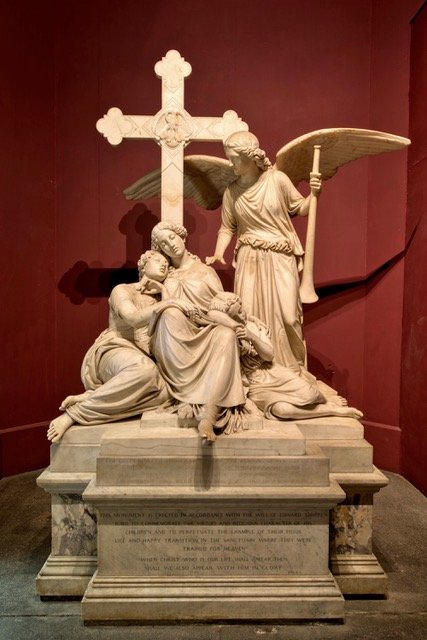Friday Anniversary Perspectives Opened Up Close: The Power of Soft
Steinhäuser Burd Children’s Memorial, 1852
For all the compelling power of the whole, the story within the Burd Children’s Memorial pivots on a single detail: the breathtaking gesture of the Angel of the Resurrection.
Steinhäuser Burd Children’s Memorial
To awaken these siblings sitting “asleep” in death, the formidable angel simply moves to touch the shoulder of the eldest, pausing in its mission to blast us all awake with its trumpet. As St. Paul wrote: “In a moment, in the twinkling of an eye, at the last trump: for the trumpet will sound, and the dead shall be raised incorruptible, and we shall be changed” (I Corinthians 15:52; KJV).
Images standardly render this “moment” as a collective awakening to earsplitting sound—produced by angels trumpeting overhead.
Steinhäuser instead offers the transformative power of soft, in hushed intimacy on the ground, opening new space for meditation. I don’t know if there’s a source for this concept or even comparative works. Perhaps one of you knows.
But there’s more. The sculptor’s proposal says he’ll render the angel approaching and awakening them “with a slight touch.”
Instead, those who visited the completed project saw a moment JUST BEFORE the touch that provided new dimensions. Consider the enthusiastic description published repeatedly with an image of the group: The children were “about to be awakened;” viewers also saw the angel’s reaction to them as revealing its own spiritual depth: “Struck by the group, the angel pauses for an instant as if in contemplation” (Illustrated News, July 9, 1853, 13]. It’s no wonder the group was soon dubbed “The Angel of the Resurrection” rather than a resurrection scene.
Our mind is invited to ponder what we see and don’t: to imagine why the children were so special, what’s to come, what the angel sees and feels, and whatever else emerges as we contemplate.
Detail, AZ Shindler, Painting of St. Stephen’s Interior, by 1858
I’m struck that visitors saw this subtlety when viewing the marble at a distance in its original setting: behind grill gates and an ornate barricade, washed by daylight from an overhead skylight. The memorial “chapel” became an unearthly vision especially if daylight caused the burgundy walls to glow, as in Shindler’s view of the church interior painted soon after the project was finished.
With subsequent changes to the Burd “chapel” as the growing church enveloped it, we can now approach the marble at will. Up close, you may see space between the angel’s finger and the girl’s shoulder. That distance provides the “about” to the life-giving touch aiming to connect, tenderly.
We witness a miracle about to occur with the power of soft. Through virtuosic sculptural handling, we are offered extraordinary storytelling. Through that storytelling’s subtlety and radical newness, we are invited to engage with our minds.
Suzanne Glover Lindsay, St. Stephen’s historian and curator



